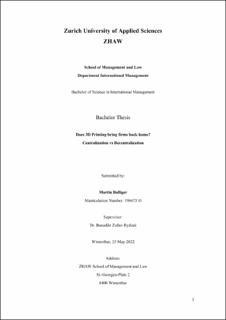Bitte benutzen Sie diese Kennung, um auf die Ressource zu verweisen:
https://doi.org/10.21256/zhaw-26516| Publikationstyp: | Thesis: Bachelor |
| Titel: | Does 3D printing bring firms back home? : centralization vs decentralization |
| Autor/-in: | Bolliger, Martin |
| Betreuer/-in / Gutachter/-in: | Zoller-Rydzek, Benedikt |
| DOI: | 10.21256/zhaw-26516 |
| Umfang: | 112 |
| Erscheinungsdatum: | 2022 |
| Verlag / Hrsg. Institution: | ZHAW Zürcher Hochschule für Angewandte Wissenschaften |
| Verlag / Hrsg. Institution: | Winterthur |
| Sprache: | Englisch |
| Fachgebiet (DDC): | 670: Industrielle und handwerkliche Fertigung |
| Zusammenfassung: | With the expiry of several important patents in the field of additive manufacturing in the last decade, a revolution in manufacturing in various industries was expected. The new possibilities of additive manufacturing presented new strategic challenges for management. The aim of this paper is to investigate the factors needed for Additive Manufacturing to become established in dentistry. In addition, the impact on centralised or decentralised production was investigated. The thesis focuses on the production of dental crowns. An analysis in 2012 revealed that more than one in five people in the lowest income bracket in Switzerland avoid going to the dentist because of the related costs. Therefore, the analysis should help to display solutions to solve the problem with the support of the Additive Manufacturing. Based on a detailed review of the literature in the field of Strategic Cost Management, Quality Management, Process Management as well as Innovation Management and the semi-structured interviews a flow chart model was created. It displays the relevant factors required, that Additive Manufacturing will be implemented on a large-scale basis in dentistry in Switzerland. The primary data collection was based on five semi-structured interviews with six experts in the dentistry business. In order to obtain a meaningful research result, the entire value chain was surveyed. Thus, the different needs of dental chains, dentists and dental laboratories could be shown to simplify the implementation. The results of the interviews showed that dentists rely on proven methods with long-term studies. It further became apparent that dentist and dental laboratories in Switzerland prefer to work with ceramics to produce dental crowns. Furthermore, it has become apparent that suppliers of 3D Printers are involved in the research and development of such materials. However, there are currently no certificates or materials that are permitted for permanent use. Another finding from the research was that the current dental tariff is a barrier to new innovations. Due to the fixed tariffs, no incentive is created to introduce new cost-effective innovations. It was also revealed that many different factors are decisive for the choice of treatment and the choice of materials for dental crowns. Due to this a complete decentralization of tooth crown manufacturing in the dental surgery seemed currently as not justifiable. To conclude, Additive Manufacturing has many positive aspects and is suitable for the dentistry business. However, there are currently several factors which prevent a large-scale introduction of the technology. These are the printable materials as well as the biocompatibility and the clinical studies. Furthermore, there need to be an agreement with the SSO to foster the technology and to adjust the current dental tariff. If those factors together with the supportive factors mentioned in the research paper can be tackled, the large-scale implementation of Additive Manufacturing will take place. A limitation of the research study was that the customer side has not been included and further research to explore customer’s expectations is suggested. |
| URI: | https://digitalcollection.zhaw.ch/handle/11475/26516 |
| Lizenz (gemäss Verlagsvertrag): | CC BY-NC-ND 4.0: Namensnennung - Nicht kommerziell - Keine Bearbeitungen 4.0 International |
| Departement: | School of Management and Law |
| Enthalten in den Sammlungen: | BSc International Management |
Dateien zu dieser Ressource:
| Datei | Beschreibung | Größe | Format | |
|---|---|---|---|---|
| 2022_Bolliger_Martin_BSc_IM.pdf | 1.48 MB | Adobe PDF |  Öffnen/Anzeigen |
Zur Langanzeige
Bolliger, M. (2022). Does 3D printing bring firms back home? : centralization vs decentralization [Bachelor’s thesis, ZHAW Zürcher Hochschule für Angewandte Wissenschaften]. https://doi.org/10.21256/zhaw-26516
Bolliger, M. (2022) Does 3D printing bring firms back home? : centralization vs decentralization. Bachelor’s thesis. ZHAW Zürcher Hochschule für Angewandte Wissenschaften. Available at: https://doi.org/10.21256/zhaw-26516.
M. Bolliger, “Does 3D printing bring firms back home? : centralization vs decentralization,” Bachelor’s thesis, ZHAW Zürcher Hochschule für Angewandte Wissenschaften, Winterthur, 2022. doi: 10.21256/zhaw-26516.
BOLLIGER, Martin, 2022. Does 3D printing bring firms back home? : centralization vs decentralization. Bachelor’s thesis. Winterthur: ZHAW Zürcher Hochschule für Angewandte Wissenschaften
Bolliger, Martin. 2022. “Does 3D Printing Bring Firms Back Home? : Centralization Vs Decentralization.” Bachelor’s thesis, Winterthur: ZHAW Zürcher Hochschule für Angewandte Wissenschaften. https://doi.org/10.21256/zhaw-26516.
Bolliger, Martin. Does 3D Printing Bring Firms Back Home? : Centralization Vs Decentralization. ZHAW Zürcher Hochschule für Angewandte Wissenschaften, 2022, https://doi.org/10.21256/zhaw-26516.
Alle Ressourcen in diesem Repository sind urheberrechtlich geschützt, soweit nicht anderweitig angezeigt.